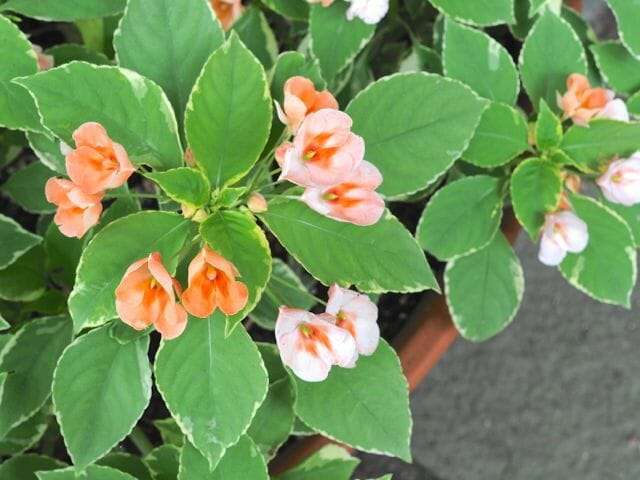downy mildew: don't compost sickly impatiens

All Impatiens walleriana types are potentially affected. That’s the species that the common garden impatiens is bred from, as are the double-flowered types and miniatures and the Fusion series I like so much (that’s variegated Fusion Peach Frost, above). Other impatiens species may likewise be susceptible–even the native jewelweed, Impatiens capensis.
The updated Impatiens Downy Mildew factsheet from Cornell Cooperative Extension explains that early signs of infection may have been leaves that looked yellowish, as if the plant needed feeding, or foliage that curled under or seemed to wilt. Sometimes, you can see a white material (the fungus) on the undersides of leaves. Eventually, plants may defoliate, drop their flowers, and basically collapse. The American Floral Endowment website has detailed photos of symptomatic plants, and other links (most geared to growers) about this threat to a favorite bedding plant.





Thanks for this update on sickly impatiens as I was wondering what had happened as all my potted impatiens started dying off mid summer. I will plant something else next Spring but am wondering how long the spores will last in the potted soil.
Thanks Margaret for this update. My impatiens have suffered this fate and it’s a shame because, with the weather we’ve been having of late, they would have been fabulous!!
Photo number 3 could have been taken in my yard. Next year I guess I’ll get New Guineas. Thanks for the information.
Hi, Sherry. I lost some pots and not others. Very oddball. Many friends lost all of them. Always something!
Is confining them to the trash not just sending the problem elsewhere? Would it not be better to be burnt? Or if composted, then compost for at least two years as most diseases are not present after that.
“The composting process can destroy many plant pathogens. Because of this, diseased plant material should be thermophilically composted rather than returned to the land where reinoculation of the disease could occur.” Humanure Handbook 3rd edition (https://humanurehandbook.com/downloads/Humanure_Handbook_all.pdf)
A useful warning for those who need it. We have to be careful about box clippings here.
Thanks, Margaret – you solved a mystery in our Chicago garden. The links you provided were very helpful. Will you be taking a chance with more impatiens next year? The links suggest this might be a problem for a few years. Thanks again – and cant wait for the release of your new book!
I had impatiens in 5 large pots. Three that were next to each other outside my back door suddenly lost all of their leaves and just literally dropped dead. It was the weirdest thing. The other 2 pots, outside the front door are still doing well. I had no idea what was happening, so thanks for the info.
My impatiens were beautiful util about 5weeks ago. Now they are gone, and so are all the impatiens in the neighborhood. I live in Lakewood Ohio. I have heard that nurseries around here will not carry them next year.
I live in California, and use the same two pots for my Impatiens every year. Last year and this year, the leaves began to turn whitish, and the plants did poorly. I had to cut them way back recently, but too late for them to come back. I guess I will discard the plants, soil and disinfect the pots!
Hi, Rhoni. Sounds like you definitely had downy mildew. I agree: do a real housekeeping, everything including soil. Good idea!
Hi, Bob. I hope by next year they figure out how to cope with this issue better, but it may take awhile. Interesting that your nursery thinks it’s a no-go next year — I won’t be surprised to hear that at more places.
Thank you, Margaret, for this update. I am in Columbia County (Greenport), and had wondered what had happened to an entire bed of impatiens. Those in pots seemed to do fine. I usually bring these in and they have overwintered beautifully. Do you recommend doing this this winter?
Yep, it was bad here in the Chicago area. It happened to mine and to my clients’ impatiens. At least it came late in the season, and Diamond Frost euphorbia fillers helped disguise the naked stems. But in the last two weeks they’re all looking done. Next year it’s gonna be begonias instead – a lot less watering needed and they all still look fantastic, including the lowly wax begonias I’ve come to like a lot more than bedding impatiens. Some of my favorite shade containers this year have Dragon Wing begonias in them.
I love Dragon Wing begonias, Linda. A favorite here, too. Good idea!
A couple of years ago I was able to find the beautiful pale orange impatiens in your photo. They seem to have disappeared around the NYC metro area, nurseries/plant shops, etc. Can you give us the proper name for this variety?
Thanks, J
Yes, Janet, it’s in the article — it’s the Fusion Series, and specifically Fusion Peach Frost (meaning peach flowers and variegated or frosted leaves). I asked my nursery in late winter to be sure to order Fusion impatiens for me. I actually even like the un-variegated ones better, like Fusion Glow.
Hi, Margaret! We had mixed success much like you and a few others. Some containers have done spectacular, while others have succumbed to the mildew. Hard to figure out the whys and hows of the selective and isolated events. Thanks for the heads-up about not composting. Let’s hope for some stronger plants in the future.
Tom/@SolakNC
Margret….must be blind today…it was in the article…sorry; still many thanks.
J
I’m so glad to read this article about the impatiens. I also bought Fusion, I loved them but like you said, they wilted, lost their leaves, now I have sticks, that I’ll pull out tomorrow. My neighbor told me that the rabbits are eating them. Because this is our first year without a cat. Our cat died in the winter, we never had a problem with rabbits until now.
I’m in Putnam County and the few I planted were fine…but the 2 flats I planted at my mom’s house on Long Island died so early. And those are her favorites to plant for bedding! I had heard about this from some friends in the midwest who were also hit.
Fortunately, this year she had included some begonias which did just fine!
BTW, the deer left my begonias, nasturtiums and caladiums alone all summer but suddenly started eating them. They did the same last year! There’s still plenty of other food to eat right now, so why the change in eating habits?
I am grateful, though, that I at least got to enjoy them all summer, but I was just wondering?
Hi Margaret,
Does it seem to you that once they start fooling around with good old standbys with tissue culture to develop the latest and greatest that next thing we hear about is disease problem. I know it has happened with Hemoracallis, Hostas, Roses and now we have poblems with Impatiens. I found a Red Impatiens with varigated foliage at a K mart and thought i was wonderful but now i wonderif I should not destroy it . Any thoughts?
Thanks so much for solving the mystery of what happened to most of my impatiens! It started right after a week in which we had 6 1/2 inches of rain (Raleigh, NC) about a month ago. They just suddenly lost all their leaves, and no, it wasn’t deer or rabbits, even ones in pots on the deck turned into sticks. The only two that survived were those that were in too much sun or too dry a spot. Guess those conditions were not favorable for the fungus. Several of my neighbors had the same problem.
Question — is it worth removing the soil and trying again next year or are the spores airborne and floating around anyway? Would it help if I started my impatiens next year from seed rather than nursery flats? There’s nothing else for damp shade with that gorgeous coral color I love.
Sorry to hear, Marilyn. I don’t know and have been busily reading the nursery-industry reports linked in the story to get some advice. The September update says it would be “prudent” to plant something different next year if there was an infection this year. The oospores (survival spores) overwinter in the soil…unless it was just a stray pot, not sure how you’d really get rid of the soil.
Good morning, I’m new here, but love your blog. Thanks for all the great reading. I have a question, I have started my first compost pile…yeah!!!…anyway, my problem is that, I have already thrown my plants into my pile. They had the fungus for sure ( I thought some critters were snacking on them). My compost pile is up at my cottage in Western NY, and I am now down in Fl. until the spring. I had a few pots that were thrown in, does this mean that all my compost will have this fungus? Thanks so much for all your advise….I look forward to reading all your post, as I am a newbie to all gardening….but loving every second. Best regards, Michelle
Hi, Michelle. I think the best bet for any of us who had an issue: skip a year of impatiens. Don’t worry about your compost; it will be fine (unless you planned to grow impatiens in it, tee hee).
Hello, thank you for your article. My window boxes of impatiens had the downy mildew, but I didn’t know what it was, at the time. As I’m getting ready to plant new flowers for this season, should I discard and replace all soil that was used with the impatiens that were sick? Thanks.
Yes, it’s critical to start with a sterile medium and everything clean, I think, when there is any risk of carrying over disease.
Thank you so much for your response, Margaret. Have a great day.